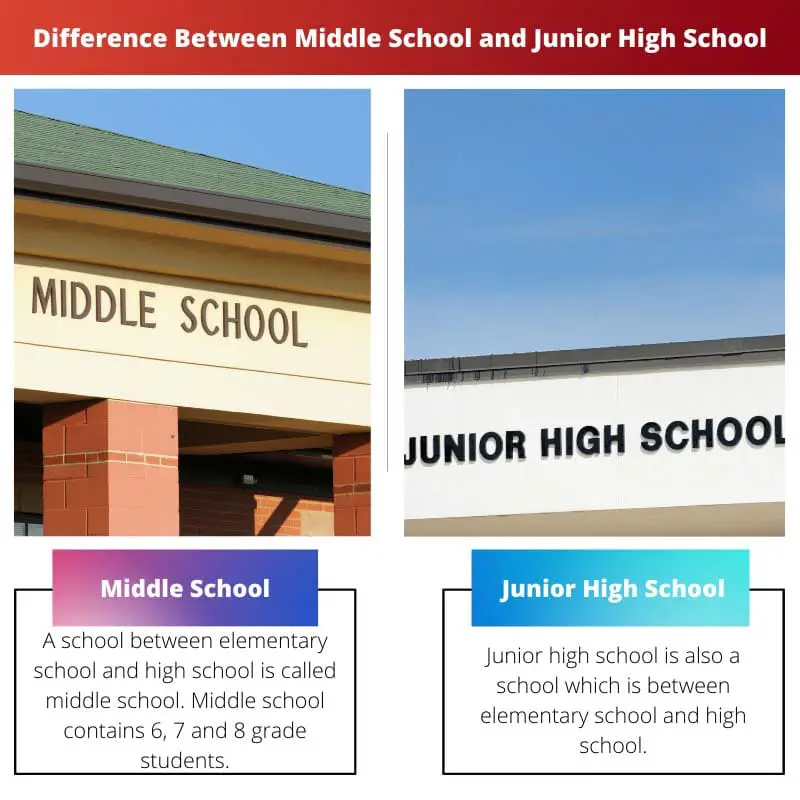Middle School and Junior High are both educational institutions catering to early adolescent students, aged 11 to 14. However, Middle Schools focus on a broader, more holistic approach to education, emphasizing developmental needs, while Junior High Schools adopt a more departmentalized structure, resembling a miniaturized version of high school with separate classes for different subjects.
Key Takeaways
- Middle schools include grades 6-8, while junior high schools include grades 7-9.
- Middle schools focus on interdisciplinary learning, while junior high schools may have a more subject-specific curriculum.
- Middle schools are part of a K-12 system, while junior high schools may be separate institutions.
Middle School vs Junior High
The middle school emphasizes different aspects of a student’s life, including social, physical, mental, emotional, etc., and focuses on exploring. Junior High school focuses on the subjects being taught to the students along with enhancing mental abilities. It focuses on academics.

The preschool level is the level at which formal education starts.
It then moves on to the elementary or primary level, then to the secondary level, colleges, and other higher levels. Before reaching the higher levels, an individual must first pass all the lower levels of education.
Some educational institutes require students to complete and pass a middle school or a junior school to attend and proceed to high school
while some institutes do not require such things, and students automatically proceed to high school after completing their elementary education.
Comparison Table
| Feature | Middle School | Junior High School |
|---|---|---|
| Focus | Collaborative learning, social & emotional development | Academic rigor, preparing for high school |
| Grade levels | Typically 6th-8th | Typically 7th-9th |
| Schedule | Often block schedule with longer classes | Traditional 6-8 period schedule with shorter classes |
| Classes | More exploratory and interdisciplinary | More focused on core academic subjects |
| Elective choices | Fewer electives, focused on exploration | More elective options |
| Teacher model | Often self-contained teams with one teacher for multiple subjects | Departmentalized with different teachers for each subject |
| Social environment | Smaller, more nurturing environment known for transitioning students from elementary to high school | Can be larger and more independent environment, seen as a mini high school |
What is Middle School?
Middle school, also known as junior high in some regions, is an educational institution that bridges the gap between elementary school and high school. It serves students in grades six through eight, although the exact grade range can vary depending on the educational system and regional practices.
Educational Philosophy
Middle schools are designed to cater specifically to the unique developmental needs of early adolescents, who are undergoing significant physical, emotional, and cognitive changes. The educational philosophy of middle schools is centered around addressing these needs through a holistic approach to education.
Curriculum and Instruction
Middle schools offer a comprehensive curriculum that includes core subjects such as mathematics, language arts, science, and social studies, as well as elective courses like art, music, physical education, and foreign languages. The curriculum is designed to provide students with a well-rounded education while also allowing for exploration and discovery.
In terms of instruction, middle schools may employ interdisciplinary teaching methods that integrate multiple subject areas, allowing students to make connections between different disciplines. This approach aims to promote critical thinking, problem-solving skills, and creativity.
School Structure and Environment
Middle schools have a team-based or house system, where a group of teachers works closely with a specific cohort of students. This setup fosters a sense of community and provides students with a supportive network of adults who can address their academic and social-emotional needs.
The physical environment of middle schools is designed to accommodate the unique needs of early adolescents. Facilities may include spaces for collaborative learning, flexible seating arrangements, and areas for extracurricular activities and social interaction.
Transition to High School
One of the primary goals of middle school is to prepare students for the transition to high school both academically and socially. Middle schools may offer transition programs or activities to help students navigate this change and develop the skills and confidence they need to succeed in high school and beyond.

What is Junior High School?
Junior high school is an educational institution that serves as an intermediary between elementary school and high school. It caters to students in grades seven through nine, although the specific grade range can vary depending on regional practices and educational systems.
Educational Philosophy
Junior high schools adopt a more departmentalized approach to education, resembling a miniature version of high school. The educational philosophy of junior high schools focuses on preparing students for the academic rigor and structure of high school while providing a foundation in core subject areas.
Curriculum and Instruction
Junior high schools offer a curriculum that includes core subjects such as mathematics, language arts, science, and social studies, as well as elective courses in areas like art, music, physical education, and technology. The curriculum is structured to provide students with a solid academic foundation and to introduce them to a range of subjects and disciplines.
In terms of instruction, junior high schools employ subject-specific teachers who specialize in particular subject areas. Classes are organized around departmental lines, with students rotating between different classrooms throughout the day.
School Structure and Environment
Junior high schools may have a more departmentalized structure than middle schools, with separate academic departments for each subject area. This organizational structure allows for a greater emphasis on subject-specific instruction and academic specialization.
The physical environment of junior high schools may include traditional classroom settings as well as specialized facilities for subjects like science labs, computer labs, and art studios. The school layout is designed to accommodate the departmentalized structure and to facilitate efficient movement between classes.
Transition to High School
Like middle schools, junior high schools also play a role in preparing students for the transition to high school. They provide students with the academic skills and knowledge they need to succeed in high school-level courses, as well as opportunities for extracurricular involvement and personal growth.

Main Differences Between Middle School and Junior High
- Grade Levels:
- Middle schools encompass grades 6 to 8, with students transitioning from elementary school to high school.
- Junior high schools cover grades 7 to 9, serving as an intermediate stage between elementary and high school.
- Educational Philosophy:
- Middle schools emphasize a developmental approach, focusing on meeting the unique needs of early adolescents through interdisciplinary teaching and team collaboration.
- Junior high schools may adopt a more traditional academic model, with a departmentalized structure and subject-specific teachers.
- Curriculum Organization:
- In middle schools, the curriculum may be organized thematically or by interdisciplinary teams, allowing for greater integration of subjects and project-based learning.
- Junior high schools follow a departmentalized structure, with students rotating through different classes and teachers for separate subjects.
- Student Experience:
- Middle schools prioritize creating a supportive and inclusive environment for students during a critical period of social and emotional development.
- Junior high schools may focus more on academic rigor and preparation for high school, with less emphasis on social and emotional support programs.
- Facility Size and Structure:
- Middle schools may have smaller class sizes and a more intimate learning environment, catering to the needs of early adolescents.
- Junior high schools may have larger student populations and more extensive facilities, resembling a miniature high school setting.
- Extracurricular Activities:
- Middle schools may offer a wide range of extracurricular activities and clubs aimed at promoting student involvement and exploration of diverse interests.
- Junior high schools may focus more on competitive sports and academic teams, preparing students for high school-level competitions and achievements.
- Transition to High School:
- Middle schools provide transition programs and support services to help students adjust to the academic and social demands of high school.
- Junior high schools may place greater emphasis on academic preparation and readiness for high school-level coursework and expectations.





